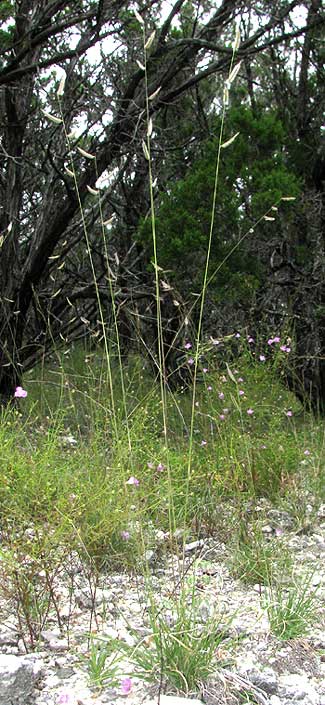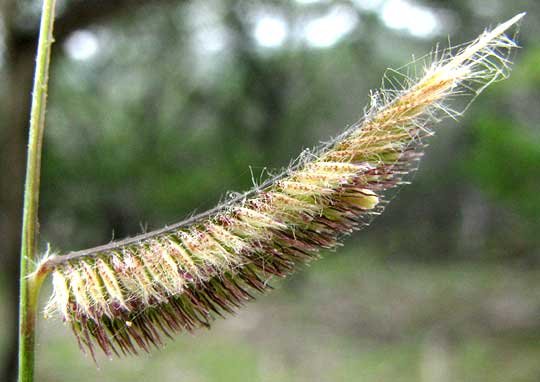Excerpts from Jim Conrad's
Naturalist Newsletter
from the October 14, 2012 Newsletter issued from the valley of the Dry Frio River in northern Uvalde County, southwestern Texas, on the southern border of the Edwards Plateau; elevation ~1750m (~5750 ft); N29.62°, W99.86°; USA
EYEBROW GRASS, OR TALL GRAMA

In thin, dry soil on the upper slopes of the limestone hill in front of the cabin there's a perennial clumpgrass producing smallish tufts of grass from which arise slender hip-high inflorescences looking far too tall for such a small grass. The inflorescences catch the eye because they look like fuzzy eyebrows oddly stuck onto the very slender stems, or rachises. Below, you can see what this looks like:

This grass is often known as Eyebrow Grass, but more formal literature usually refers to it as Tall Grama. It's BOUTELOUA PECTINATA. Besides the tall inflorescences arising from such meager herbage, another field mark for the species is how each eyebrow, or inflorescence branch, ends with a flowerless, or "naked," projection. That spine-like projection makes Eyebrow Grass a little undesirable to grazing cattle and deer. That may be the point of the point: To keep critters from eating it.
Eyebrow Grass is endemic to Texas and maybe a tiny part of Oklahoma. Actually, some authorities regard this species as a mere variety of the much more widely distributed Hairy Grama, Bouteloua hirsuta, but some who have the most field experience with the species insist that it's a distinct species.
We looked at another grama grass -- a member of the genus Bouteloua -- in our September 30 newsletter. That was Sideoats Grama, Bouteloua curtipendula, Texas's state grass. Bouteloua is a native American genus its center of diversification apparently in Mexico. About 24 species are recognized.
Grama grasses are "C4 grasses," which means that during the evolution of the Grass Family a certain ancestor blundered upon a more efficient photosynthetic pathway than the one usually taught in school, and which most plants use. This innovation, maybe a mutation, enables C4 grasses to capture carbon dioxide from the air more efficiently, resulting in less water being lost through transpiration. Thus the genus Bouteloua has a definite physiological advantage over other plants not benefiting from the C4 pathway.